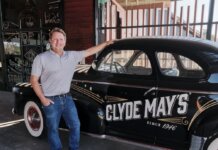
You may not know what biophilia is, but you’ve probably experienced it. The term means that humans tend to seek connections with nature.
It’s not a word you expect a corporate executive to use, so when SmartLam North America CEO Derek Ratchford brings it up, you can’t help but be intrigued.
SmartLam makes wood construction products at two locations — Dothan and Columbia Falls, Montana.
The company just invested $60 million in a new manufacturing facility in Dothan adjacent to the existing cross-laminated timber, or CLT, plant. The new facility spans 144,000 square feet and is designed to produce 84 million board feet of glulam beams and columns each year.
Glulam is glued, laminated timber that bonds boards, or lams, to create a building product that can be as strong as steel.
Dothan’s glulam beam manufacturing division and the CLT plant are about 75 yards apart. A total of 113 people work in manufacturing and another 10 in management. The Montana division employs roughly 100.

In all, he says, “we’re right at 223 employees.”
SmartLam is the largest mass timber – an umbrella term for CLT and glulam – producer in North America. The Dothan operation can produce beams up to 60 feet long.
The company started in Montana in 2012. In 2019, they acquired IB X-Lam in Dothan, a CLT and glulam plant that had been operating since 2018.
“We were the first CLT producer in the U.S.,” says Ratchford. “The Europeans have been doing this for about 36 or 38 years with cross-laminated timber and glulam components, because their building practices use less concrete and steel than the U.S. does.”
All buildings were once made of wood only, he notes, “until you wanted 100-story buildings, and they start using steel and concrete.”
SmartLam’s products are showing up in high-profile projects across the country, including a flagship Apple store in Florida.
Ratchford compares the product’s engineering concept to a support beam across a garage door in a house. Forces are trying to push that beam down, creating tension at the bottom and compression at the top. The strength of lumber needed differs depending on the stresses.
“The beams are engineered to handle the compression and tension loads,” says Ratchford. “The columns that we make are all in compression and it’s just one single grade. What you do is design the columns and then you attach the beams to them.
“We do framing-grade, industrial and architectural commodity for residential and light duty commercial,” he says. “But all of our project glulam that we do for these large jobs where beams are exposed is architectural.”

You can’t buy the wood they use at Lowe’s or Home Depot, Ratchford explains. SmartLam sources its raw material directly from sawmills.
“We’re not using your typical lumber. We are high-grading lumber, visually grading each stick of lumber, and it’s selected based on its strength. Then it goes into an engineered layup that we have in a computer program that lays it up that way,” he says.
“We glue it, we press it, we plane it, we sand it, and then we seal the CNC project glulam, and we attach hardware.”
The company creates 3D models for each building project to determine where the product will go. Using tags and QR codes, construction crews know exactly where to place the beams.
“Every single individual column or beam or CLT panel has a panel ID and a number. Then it goes in a specific location. You cannot use one column everywhere,” he says.
“You set your columns first and they’ve got the steel attached to them,” he adds. “Then you take your beams that have the steel attached to them and you connect them, pick the crane up, set them down, connect them, and it’s just like Legos to a degree.”

Beams can be covered with sheetrock or left exposed for architectural design impact. SmartLam’s “Smartshafts” are used in elevator and stairwell shafts.
The Dothan location works with mostly yellow pine but can process spruce and Douglas fir, too. The Montana operation gets about half of its wood from Montana and the remainder from Oregon, Washington and Canada.
Most of the company’s pine comes from mills in the Southeast that are owned by four shareholders.
“We kind of pick and choose and they each pull certain specific grades for us,” says Ratchford. “We do buy some on the open market.”
Quality pine is abundant in the Southeast, he says, making the expansion at the Alabama operation an easy decision.
“We’re in the best wood basket in North America,” he says. “The Southern pine fiber basket and our shareholder ownership has 1.6 billion board feet of fiber available to us.”
The mass timber demand is growing as builders use it for LEED certification, a specific architectural design or lower carbon emissions from a natural material. Wood is more forgiving in earthquake zones, too, because it flexes. City leaders are choosing it for downtown regentrification projects, he says, and universities are incorporating the wood look in many new buildings.

“There’s a million reasons why people may or may not build with this product,” Ratchford says. “They want a different look, a different feel versus just sheetrock and tile ceilings. They just want the uniqueness and comfort of wood and the warmth of wood.”
The renewable resource is becoming common in grade school designs from France to Japan. Studies show that students whose schools have a lot of exposed wood score 3% to 5% higher on tests, Ratchford says.
According to an article in School Construction News, “School interiors that feature wood and bring nature indoors provoke positive psychological responses similar to how trees elicit biophilic responses. Wood in classrooms has even been shown to reduce stress and heart rates in students.”
“Whether it’s aesthetics or the biophilia, people just feel better in wooden buildings,” says Ratchford. “They like wood. It’s the same reason you build a log home.
“People just feel calmer and more productive in wooden buildings than just cold, sterile sheetrock and ceiling tiles. And you can mix and match. You can have some of both.”
SmartLam products have been used at the Wiregrass Innovation Center in Dothan, at Auburn University, a Virginia Microsoft data center, at the Walmart campus in Arkansas and The Offices at Southstone Yards near Dallas.
“We’ve done the only Apple store out of mass timber in Miami,” he says.
Ratchford expects the company will grow with the expanding market, but for now they are “just focused on filling both plants out and maximizing the capacity.”
Next year is shaping up to be “phenomenal,” he says.
Deborah Storey and Stew Milne are freelance contributors to Business Alabama. She is based in Huntsville and he in Auburn.
This article appears in the June 2025 issue of Business Alabama.



